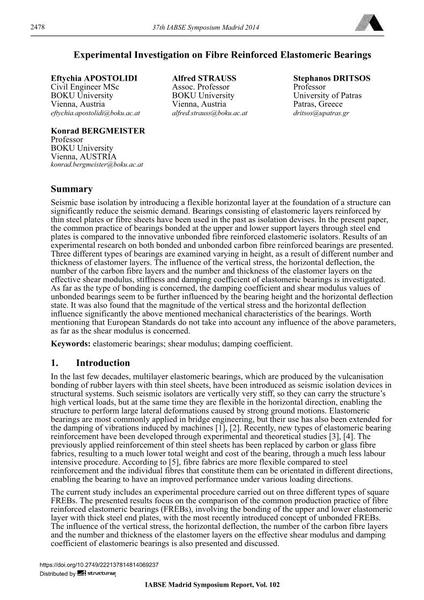Experimental Investigation on Fibre Reinforced Elastomeric Bearings

|
|
|||||||||||
Bibliografische Angaben
| Autor(en): |
Eftychia Apostolid
Alfred Strauss Stephanos Dritsos Konrad Bergmeister |
||||
|---|---|---|---|---|---|
| Medium: | Tagungsbeitrag | ||||
| Sprache(n): | Englisch | ||||
| Tagung: | IABSE Symposium: Engineering for Progress, Nature and People, Madrid, Spain, 3-5 September 2014 | ||||
| Veröffentlicht in: | IABSE Symposium Madrid 2014 | ||||
|
|||||
| Seite(n): | 2478-2484 | ||||
| Anzahl der Seiten (im PDF): | 7 | ||||
| Jahr: | 2014 | ||||
| DOI: | 10.2749/222137814814069237 | ||||
| Abstrakt: |
Seismic base isolation by introducing a flexible horizontal layer at the foundation of a structure can significantly reduce the seismic demand. Bearings consisting of elastomeric layers reinforced by thin steel plates or fibre sheets have been used in the past as isolation devises. In the present paper, the common practice of bearings bonded at the upper and lower support layers through steel end plates is compared to the innovative unbonded fibre reinforced elastomeric isolators. Results of an experimental research on both bonded and unbonded carbon fibre reinforced bearings are presented. Three different types of bearings are examined varying in height, as a result of different number and thickness of elastomer layers. The influence of the vertical stress, the horizontal deflection, the number of the carbon fibre layers and the number and thickness of the elastomer layers on the effective shear modulus, stiffness and damping coefficient of elastomeric bearings is investigated. As far as the type of bonding is concerned, the damping coefficient and shear modulus values of unbonded bearings seem to be further influenced by the bearing height and the horizontal deflection state. It was also found that the magnitude of the vertical stress and the horizontal deflection influence significantly the above mentioned mechanical characteristics of the bearings. Worth mentioning that European Standards do not take into account any influence of the above parameters, as far as the shear modulus is concerned. |
||||
| Stichwörter: |
Elastomerlager
|
||||
